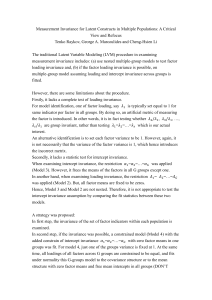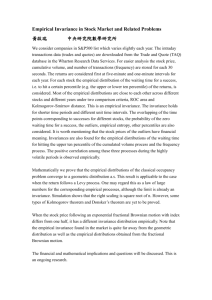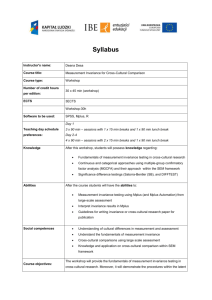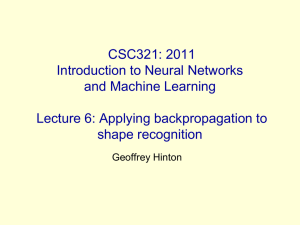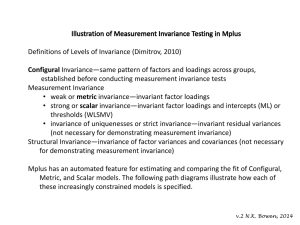slides in pdf
advertisement
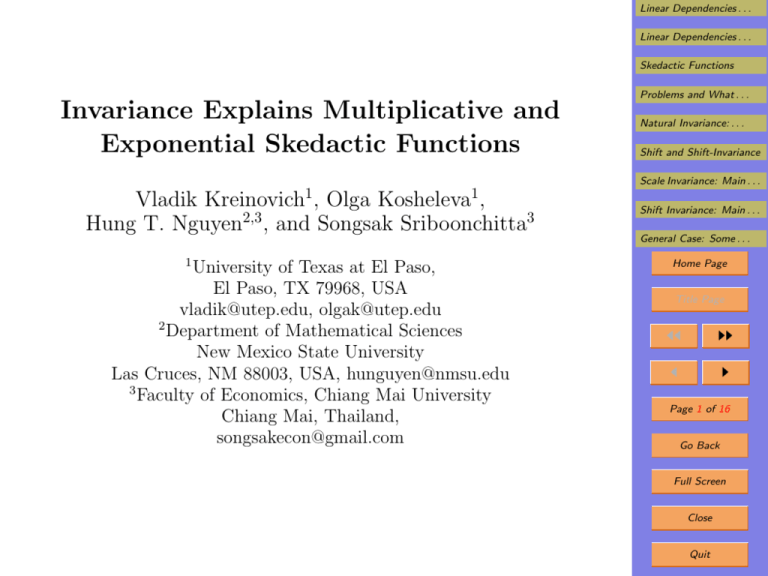
Linear Dependencies . . . Linear Dependencies . . . Skedactic Functions Problems and What . . . Invariance Explains Multiplicative and Exponential Skedactic Functions Natural Invariance: . . . Shift and Shift-Invariance Scale Invariance: Main . . . Vladik Kreinovich1 , Olga Kosheleva1 , Hung T. Nguyen2,3 , and Songsak Sriboonchitta3 1 University of Texas at El Paso, El Paso, TX 79968, USA vladik@utep.edu, olgak@utep.edu 2 Department of Mathematical Sciences New Mexico State University Las Cruces, NM 88003, USA, hunguyen@nmsu.edu 3 Faculty of Economics, Chiang Mai University Chiang Mai, Thailand, songsakecon@gmail.com Shift Invariance: Main . . . General Case: Some . . . Home Page Title Page JJ II J I Page 1 of 16 Go Back Full Screen Close Quit Linear Dependencies . . . 1. Linear Dependencies . . . Linear Dependencies Are Ubiquitous Skedactic Functions • In many practical situations, a quantity y depends on several other quantities x1 , . . . , xn : y = f (x1 , . . . , xn ). (0) • Often, the ranges of xi are narrow: xi ≈ xi for some def (0) (0) xi , so ∆xi = xi − xi are relatively small. • Then, we can expand the dependence of y on xi = (0) xi + ∆xi in Taylor series and keep only linear terms: y= (0) f (x1 + ∆x1 , . . . , x(0) n + ∆xn ) ≈ a0 + n X Problems and What . . . Natural Invariance: . . . Shift and Shift-Invariance Scale Invariance: Main . . . Shift Invariance: Main . . . General Case: Some . . . Home Page Title Page ai · ∆xi , JJ II J I i=1 def where a0 = f (0) x1 , . . . , x(0) n ∂f and ai = . ∂xi def (0) • Substituting ∆xi = xi − xi into this formula, we get n n P P def (0) y ≈c+ ai · xi , where c = a0 − ai · x i . i=1 i=1 Page 2 of 16 Go Back Full Screen Close Quit Linear Dependencies . . . 2. Linear Dependencies Are Approximate Linear Dependencies . . . Skedactic Functions • Usually, Problems and What . . . – in addition to the quantities x1 , . . . , xn that provide the most influence on y, – there are also many other quantities that (slightly) influence y, – so many that it is not possible to take all of them into account. Natural Invariance: . . . Shift and Shift-Invariance Scale Invariance: Main . . . Shift Invariance: Main . . . General Case: Some . . . Home Page Title Page • Since we do not take these auxiliary quantities into account, the linear dependence is approximate. n P def • The approximation errors ε = y − c + ai · xi dei=1 JJ II J I Page 3 of 16 pend on un-observed quantities. Go Back • So, we cannot predict ε based only on the observed quantities x1 , . . . , xn . • It is therefore reasonable to view ε as random variables. Full Screen Close Quit Linear Dependencies . . . 3. Linear Dependencies . . . Skedactic Functions Skedactic Functions • A natural way to describe a random variable is by its moments. • If the first moment is not 0, then we can correct this bias by appropriately updating the constant c. Problems and What . . . Natural Invariance: . . . Shift and Shift-Invariance Scale Invariance: Main . . . Shift Invariance: Main . . . • Since the mean is 0, the second moment coincides with the variance v. • The dependence v(x1 , . . . , xn ) is known as the skedactic function. • In econometric applications, two major classes of skedactic functions have been empirically successful: n Q – multiplicative v(x1 , . . . , xn ) = c · |xi |γi and i=1 n P – exponential v(x1 , . . . , xn ) = exp α + γi · xi . i=1 General Case: Some . . . Home Page Title Page JJ II J I Page 4 of 16 Go Back Full Screen Close Quit Linear Dependencies . . . 4. Problems and What We Do Linear Dependencies . . . Skedactic Functions • Problems: – Neither of the empirically successful skedactic functions has a theoretical justification. Problems and What . . . Natural Invariance: . . . Shift and Shift-Invariance Scale Invariance: Main . . . – In most situations, the multiplication function results in more accurate estimates. – This fact also does not have an explanation. • What we do: we use invariance ideas to: – explain the empirical success of multiplicative and exponential skedactic functions, and – come up with a more general class of skedactic functions. Shift Invariance: Main . . . General Case: Some . . . Home Page Title Page JJ II J I Page 5 of 16 Go Back Full Screen Close Quit Linear Dependencies . . . 5. Natural Invariance: Scaling Linear Dependencies . . . Skedactic Functions • Many economics quantities correspond to prices, wages, etc. and are thus expressed in terms of money. Problems and What . . . • The numerical value of such a quantity depends on the choice of a monetary unit. Shift and Shift-Invariance Natural Invariance: . . . Scale Invariance: Main . . . Shift Invariance: Main . . . • For example, when a European country switches to Euro from its original currency, – the actual incomes do not change, but – all the prices and wages get multiplied by the corresponding exchange rate k: xi → x0i = k · xi . • Similarly, the numerical amount (of oil or sugar), changes when we change units. • For example, for oil, we can use barrels or tons. • When the numerical value of a quantity is multiplied by k, its variance gets multiplied by k 2 . General Case: Some . . . Home Page Title Page JJ II J I Page 6 of 16 Go Back Full Screen Close Quit Linear Dependencies . . . 6. Linear Dependencies . . . Scaling (cont-d) Skedactic Functions • Changing the measuring units for x1 , . . . , xn does not change the economic situations. • So, it makes sense to require that the skedactic function also does not change under such re-scaling: namely, Problems and What . . . Natural Invariance: . . . Shift and Shift-Invariance Scale Invariance: Main . . . Shift Invariance: Main . . . – for each combination of re-scalings on inputs, – there should be an appropriate re-scaling of the output after which the dependence remains the same. • In precise terms, this means that: – for every combination of numbers k1 , . . . , kn , – there should exist a value k = k(k1 , . . . , kn ) with the following property: 0 v(x01 , . . . , x0n ), v = v(x1 , . . . , xn ) if and only if v = where v 0 = k · v and x0i = ki · xi . General Case: Some . . . Home Page Title Page JJ II J I Page 7 of 16 Go Back Full Screen Close Quit Linear Dependencies . . . 7. Shift and Shift-Invariance Linear Dependencies . . . Skedactic Functions • While most economic quantities are scale-invariant, some are not. Problems and What . . . • For example, the unemployment rate is measured in percents, there is a fixed unit. Shift and Shift-Invariance • Many such quantities can have different numerical values depending on how we define a starting point. • For example, we can measure unemployment: – either by the usual percentage xi , or – by the difference xi − ki , where ki > 0 is what economists mean by full employment. • It is thus reasonable to consider shift-invariant skedactic functions: Natural Invariance: . . . Scale Invariance: Main . . . Shift Invariance: Main . . . General Case: Some . . . Home Page Title Page JJ II J I Page 8 of 16 Go Back ∀k1 , . . . , kn ∃k (v = v(x1 , . . . , xn ) ⇔ v 0 = f (x01 , . . . , x0n )), Full Screen where v 0 = k · v and x0i = xi + ki . Close Quit Linear Dependencies . . . 8. Linear Dependencies . . . Scale Invariance: Main Result Skedactic Functions • Definition. We say that a non-negative measurable function v(x1 , . . . , xn ) is scale-invariant if: – for every n-tuple of real numbers (k1 , . . . , xn ), Problems and What . . . Natural Invariance: . . . Shift and Shift-Invariance Scale Invariance: Main . . . – there exists a real number k = k(k1 , . . . , kn ) for which, for every x1 , . . . , xn and v: v= 0 v(x1 , . . . , xn ) ⇔ v = v(x01 , . . . , x0n ), v 0 = k · v and x0i = ki · xi . where • Proposition. A skedactic function is scale-invariant if and only it has the form v(x1 , . . . , xn ) = c · n Y |xi |γi for some c and γi . i=1 • Discussion. Thus, scale-invariance explains the use of multiplicative skedactic functions. Shift Invariance: Main . . . General Case: Some . . . Home Page Title Page JJ II J I Page 9 of 16 Go Back Full Screen Close Quit Linear Dependencies . . . 9. Shift Invariance: Main Result Linear Dependencies . . . Skedactic Functions • Definition. We say that a non-negative measurable function v(x1 , . . . , xn ) is shift-invariant if: – for every n-tuple of real numbers (k1 , . . . , kn ), – there exists a real number k = k(k1 , . . . , kn ) for which, for every x1 , . . . , xn and v: v = v(x1 , . . . , xn ) ⇔ v 0 = v(x01 , . . . , x0n ), where v 0 = k · v and x0i = xi + ki . Problems and What . . . Natural Invariance: . . . Shift and Shift-Invariance Scale Invariance: Main . . . Shift Invariance: Main . . . General Case: Some . . . Home Page Title Page • Result. A skedactic function is shift-invariant ⇔ ! n Y v(x1 , . . . , xn ) = exp α + γi · xi for some α and γi . i=1 • Discussion. Thus, shift-invariance explains the use of exponential skedactic functions. • It also explains why multiplicative functions are more often useful: scaling is ubiquitous, shift is rarer. JJ II J I Page 10 of 16 Go Back Full Screen Close Quit Linear Dependencies . . . 10. General Case: Some Inputs Are ScaleInvariant and Some Are Shift-Invariant Linear Dependencies . . . Skedactic Functions Problems and What . . . • Definition. We say that a non-negative measurable function v(x1 , . . . , xn ) is m-invariant if: – for every n-tuple of real numbers (k1 , . . . , kn ), – there exists a real number k = k(k1 , . . . , kn ) for which, for every x1 , . . . , xn and v: Natural Invariance: . . . Shift and Shift-Invariance Scale Invariance: Main . . . Shift Invariance: Main . . . General Case: Some . . . Home Page v v =k 0 0 = v(x1 , . . . , xn ) ⇔ v = v(x01 , . . . , x0n ), where · v, x0i = ki · xi for i ≤ m, x0i = xi + ki for i > m. • Result. A skedactic function is m-invariant ⇔ ! m n X X γi · ln(|xi |) + γi · xi . v(x1 , . . . , xn ) = exp α + i=1 Title Page JJ II J I Page 11 of 16 i=m+1 • For m = n, we get multiplicative skedactic function, for m = 0, we get the exponential one. • For other m, we get new possibly useful expressions. Go Back Full Screen Close Quit Linear Dependencies . . . 11. Acknowledgments Linear Dependencies . . . Skedactic Functions • We acknowledge the partial support of: – the Center of Excellence in Econometrics, Faculty of Economics, Chiang Mai University, Thailand, Problems and What . . . Natural Invariance: . . . Shift and Shift-Invariance Scale Invariance: Main . . . – the National Science Foundation grants: ∗ HRD-0734825 and HRD-1242122 (Cyber-ShARE Center of Excellence) and ∗ DUE-0926721. Shift Invariance: Main . . . General Case: Some . . . Home Page Title Page JJ II J I Page 12 of 16 Go Back Full Screen Close Quit Linear Dependencies . . . 12. Linear Dependencies . . . Proof of the First Result Skedactic Functions • It is easy to check that the multiplicative skedactic n Q function is scale-invariant: take k = |ki |γi . i=1 • Vice versa, the equivalence condition means that k(k1 , . . . , kn ) · v(x1 , . . . , xn ) = v(k1 · x1 , . . . , kn · xn ). v(k1 · x1 , . . . , kn · xn ) • Thus, k(k1 , . . . , kn ) = is a ratio v(x1 , . . . , xn ) of measurable functions hence measurable. • Let us consider two tuples (k1 , . . . , kn ), (k10 , . . . , kn0 ). • If we first use the first re-scaling, i.e., go from xi to x0i = ki · xi , we get v(x01 , . . . , x0n ) = k(k1 , . . . , kn ) · v(x1 , . . . , xn ). Problems and What . . . Natural Invariance: . . . Shift and Shift-Invariance Scale Invariance: Main . . . Shift Invariance: Main . . . General Case: Some . . . Home Page Title Page JJ II J I Page 13 of 16 Go Back Full Screen Close Quit Linear Dependencies . . . 13. Linear Dependencies . . . Proof (cont-d) Skedactic Functions • If we then apply, to the new values x0i , an additional re-scaling x0i → x00i = ki0 · x0i , we similarly conclude that v(x001 , . . . , x00n ) = k(k10 , . . . , kn0 ) · v(x01 , . . . , x0n ) = k(k10 , . . . , kn0 ) · k(k1 , . . . , kn ) · v(x1 , . . . , xn ). • We could also get the values x00i if we directly multiply def each value xi by the product ki00 = ki0 · ki , thus v(x001 , . . . , x00n ) = k(k10 · k1 , . . . , kn0 · kn ) · v(x1 , . . . , xn ). k(k10 k1 , . . . , kn0 • Thus, · · kn ) · v(x1 , . . . , xn ) = k(k10 , . . . , kn0 ) · k(k1 , . . . , kn ) · v(x1 , . . . , xn ). • If the skedactic function is always equal to 0, then it is multiplicative, with c = 0. • If it is not everywhere 0, this means that its value is different from 0 for some combination of values x1 , . . . , xn . Problems and What . . . Natural Invariance: . . . Shift and Shift-Invariance Scale Invariance: Main . . . Shift Invariance: Main . . . General Case: Some . . . Home Page Title Page JJ II J I Page 14 of 16 Go Back Full Screen Close Quit Linear Dependencies . . . 14. Linear Dependencies . . . Proof (cont-d) Skedactic Functions • For this tuple, we get k(k10 · k1 , . . . , kn0 · kn ) = k(k10 , . . . , kn0 ) · k(k1 , . . . , kn ). Problems and What . . . • When ki = ki0 = −1 for some i and kj0 = kj = 1 for all j 6= i, i, we get 1 = k(1, . . . , 1) = k 2 (k1 , . . . , kn ). Shift and Shift-Invariance Natural Invariance: . . . Scale Invariance: Main . . . Shift Invariance: Main . . . • Since the function ki is non-negative, this means that k(k1 , . . . , kn ) = 1. • Thus, the value k(k1 , . . . , kn ) does not change if we change the signs of ki : k(k1 , . . . , kn ) = k(|k1 |, . . . , |kn |). • Thus, ln(k(k10 · k1 , . . . , kn0 · kn )) = ln(k(k10 , . . . , kn0 )) + ln(k(k1 , . . . , kn )). • For an auxiliary function K(K1 , . . . , Kn ) ln(k(exp(K1 ), . . . , exp(Kn )), we thus get General Case: Some . . . Home Page Title Page JJ II J I Page 15 of 16 def = Go Back Full Screen K(K10 +K1 , . . . , Kn0 +Kn ) = K(K10 , . . . , Kn0 )+K(K1 , . . . , Kn ). Close Quit 15. Proof: Conclusion Linear Dependencies . . . Linear Dependencies . . . Skedactic Functions • We know that Problems and What . . . K(K10 +K1 , . . . , Kn0 +Kn ) = K(K10 , . . . , Kn0 )+K(K1 , . . . , Kn ). • It is known that measurable functions with this propn P erty are linear: K(K1 , . . . , Kn ) = γi · Ki , so i=1 k(k1 , . . . , kn ) = exp n X Natural Invariance: . . . Shift and Shift-Invariance Scale Invariance: Main . . . Shift Invariance: Main . . . General Case: Some . . . Home Page ! γi · ln(|ki |) i=1 = n Y |ki |γi . i=1 • We also have v(x1 , . . . , xn ) = k(x1 , . . . , xn ) · v(1, . . . , 1). • Thus, we get the desired formula for the multiplicative n Q skedastic function v(x1 , . . . , xn ) = c · |xi |γi . i=1 • Similar proofs hold for shift-invariance and for the general case. Title Page JJ II J I Page 16 of 16 Go Back Full Screen Close Quit
